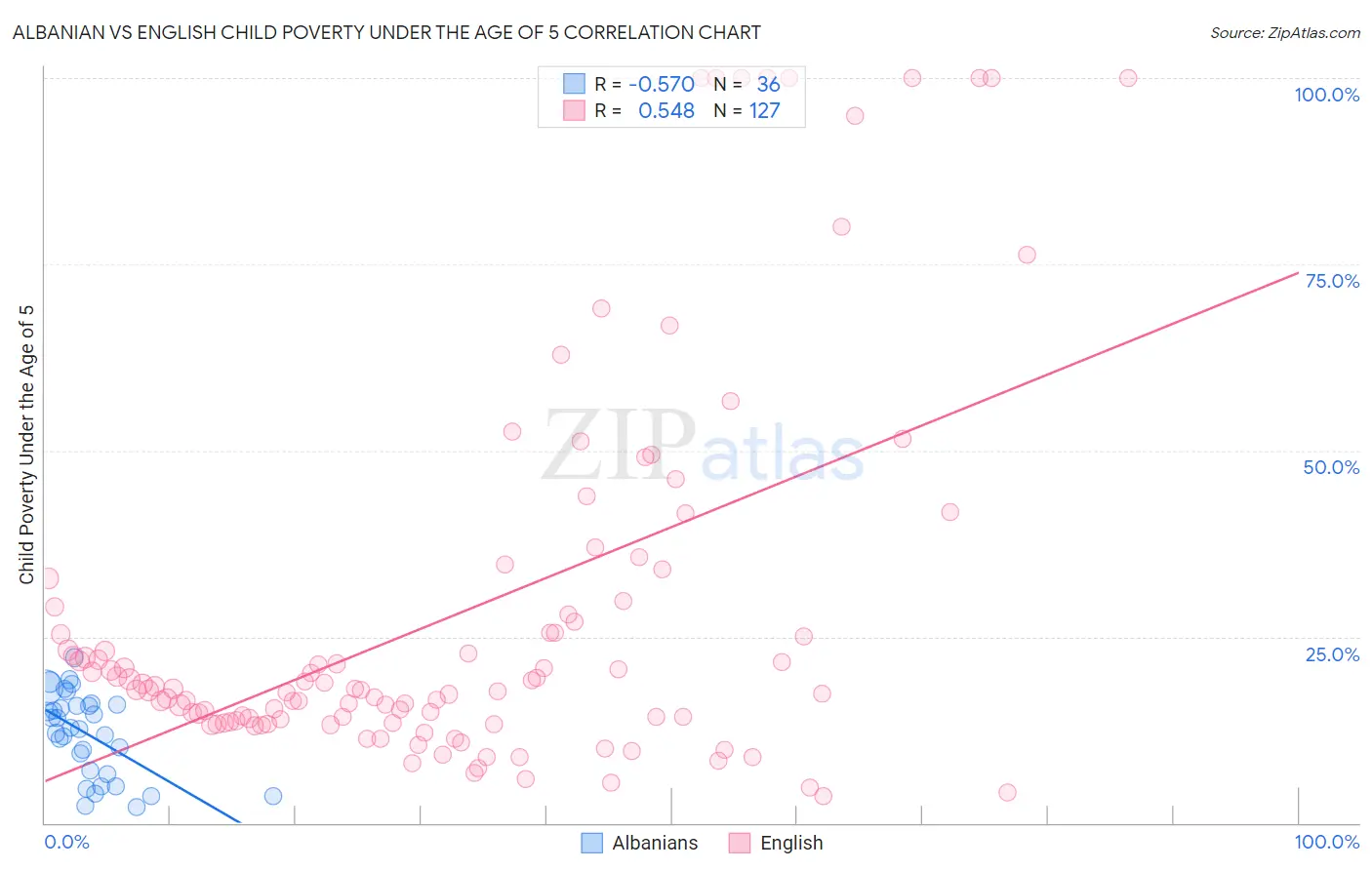Albanian vs English Child Poverty Under the Age of 5
COMPARE
Albanian
English
Child Poverty Under the Age of 5
Child Poverty Under the Age of 5 Comparison
Albanians
English
16.0%
CHILD POVERTY UNDER THE AGE OF 5
93.8/ 100
METRIC RATING
115th/ 347
METRIC RANK
16.8%
CHILD POVERTY UNDER THE AGE OF 5
70.4/ 100
METRIC RATING
161st/ 347
METRIC RANK
Albanian vs English Child Poverty Under the Age of 5 Correlation Chart
The statistical analysis conducted on geographies consisting of 186,792,170 people shows a substantial negative correlation between the proportion of Albanians and poverty level among children under the age of 5 in the United States with a correlation coefficient (R) of -0.570 and weighted average of 16.0%. Similarly, the statistical analysis conducted on geographies consisting of 535,899,350 people shows a substantial positive correlation between the proportion of English and poverty level among children under the age of 5 in the United States with a correlation coefficient (R) of 0.548 and weighted average of 16.8%, a difference of 5.2%.

Child Poverty Under the Age of 5 Correlation Summary
| Measurement | Albanian | English |
| Minimum | 2.1% | 3.5% |
| Maximum | 22.2% | 100.0% |
| Range | 20.1% | 96.5% |
| Mean | 11.9% | 28.1% |
| Median | 12.6% | 18.0% |
| Interquartile 25% (IQ1) | 6.8% | 13.6% |
| Interquartile 75% (IQ3) | 15.8% | 29.0% |
| Interquartile Range (IQR) | 9.0% | 15.4% |
| Standard Deviation (Sample) | 5.6% | 25.5% |
| Standard Deviation (Population) | 5.5% | 25.4% |
Similar Demographics by Child Poverty Under the Age of 5
Demographics Similar to Albanians by Child Poverty Under the Age of 5
In terms of child poverty under the age of 5, the demographic groups most similar to Albanians are Immigrants from Kuwait (16.0%, a difference of 0.020%), Puget Sound Salish (16.0%, a difference of 0.11%), Peruvian (16.0%, a difference of 0.12%), Pakistani (16.0%, a difference of 0.17%), and Immigrants from Austria (16.0%, a difference of 0.17%).
| Demographics | Rating | Rank | Child Poverty Under the Age of 5 |
| Immigrants | Brazil | 94.4 /100 | #108 | Exceptional 16.0% |
| Northern Europeans | 94.3 /100 | #109 | Exceptional 16.0% |
| Romanians | 94.3 /100 | #110 | Exceptional 16.0% |
| Pakistanis | 94.2 /100 | #111 | Exceptional 16.0% |
| Peruvians | 94.1 /100 | #112 | Exceptional 16.0% |
| Puget Sound Salish | 94.1 /100 | #113 | Exceptional 16.0% |
| Immigrants | Kuwait | 93.9 /100 | #114 | Exceptional 16.0% |
| Albanians | 93.8 /100 | #115 | Exceptional 16.0% |
| Immigrants | Austria | 93.5 /100 | #116 | Exceptional 16.0% |
| Basques | 93.4 /100 | #117 | Exceptional 16.0% |
| Immigrants | Denmark | 93.4 /100 | #118 | Exceptional 16.0% |
| Immigrants | Jordan | 93.2 /100 | #119 | Exceptional 16.1% |
| Immigrants | Peru | 92.6 /100 | #120 | Exceptional 16.1% |
| Mongolians | 92.5 /100 | #121 | Exceptional 16.1% |
| Immigrants | Southern Europe | 92.0 /100 | #122 | Exceptional 16.1% |
Demographics Similar to English by Child Poverty Under the Age of 5
In terms of child poverty under the age of 5, the demographic groups most similar to English are Costa Rican (16.9%, a difference of 0.060%), Scottish (16.9%, a difference of 0.21%), Irish (16.8%, a difference of 0.22%), Immigrants from Syria (16.8%, a difference of 0.25%), and Czechoslovakian (16.8%, a difference of 0.28%).
| Demographics | Rating | Rank | Child Poverty Under the Age of 5 |
| Immigrants | Venezuela | 76.0 /100 | #154 | Good 16.7% |
| South Americans | 75.1 /100 | #155 | Good 16.7% |
| Afghans | 74.4 /100 | #156 | Good 16.8% |
| Venezuelans | 73.7 /100 | #157 | Good 16.8% |
| Czechoslovakians | 72.5 /100 | #158 | Good 16.8% |
| Immigrants | Syria | 72.3 /100 | #159 | Good 16.8% |
| Irish | 72.0 /100 | #160 | Good 16.8% |
| English | 70.4 /100 | #161 | Good 16.8% |
| Costa Ricans | 69.8 /100 | #162 | Good 16.9% |
| Scottish | 68.6 /100 | #163 | Good 16.9% |
| Immigrants | Oceania | 67.6 /100 | #164 | Good 16.9% |
| Immigrants | Colombia | 66.9 /100 | #165 | Good 16.9% |
| Slavs | 64.0 /100 | #166 | Good 17.0% |
| Immigrants | Uzbekistan | 62.0 /100 | #167 | Good 17.0% |
| Uruguayans | 60.5 /100 | #168 | Good 17.0% |